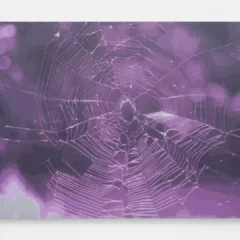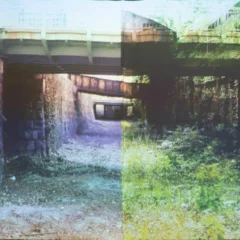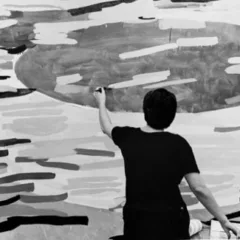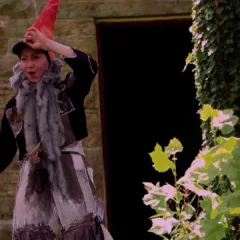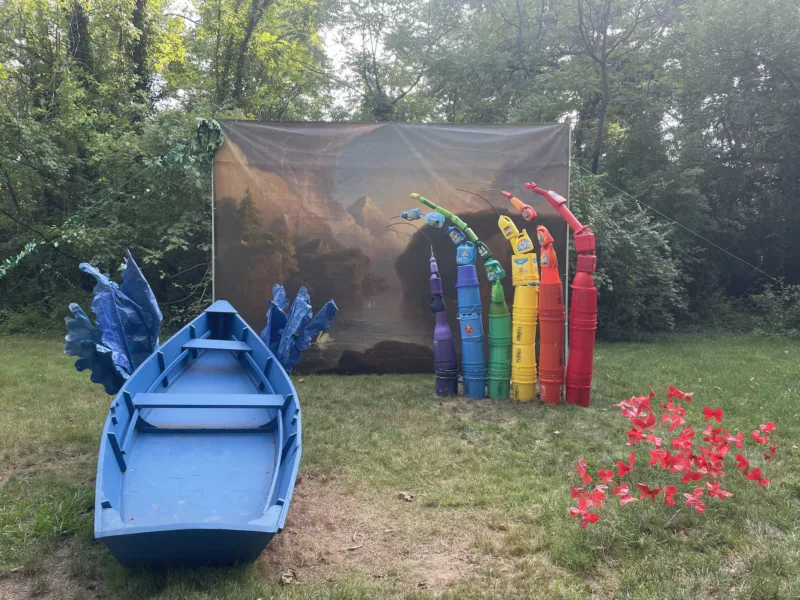
Glen Foerd is a historical house museum and public park located in the Torresdale neighborhood of Philadelphia. In the eight years since the Glen Foerd Artist-in-Residence Program started in 2015, Sarah Peoples, the 2022-23 visual arts recipient, is the first artist to receive permission to create and exhibit work on the grounds. Her proposal to work outside gave her the opportunity to further develop her ideas of what it means to place work in public areas.
In the past, Peoples has installed works surreptitiously around Philadelphia. One piece, “Rainbow,” – made of prismatic-colored plastic buckets and other containers – brightened up an empty pedestal in Lemon Hill during the pandemic. Like an ensemble actor, “Rainbow” makes an appearance as an element in the installation “America’s Landscape,” one of Peoples’s three dramatic outdoor works at Glen Foerd.
To access the piece, you walk along a path to a clearing. The Delaware River is visible to the east, and an idealized version of the Hudson River stands in front of you, in an oversized reproduction on vinyl of “Morning Among the Hills,” by the Philadelphia painter Thomas Doughty from 1830. For Peoples, the Doughty painting serves as an example of a constructed mythology where humans and nature (cue the elegant swans) coexist in a peaceful sublimity. In my conversation with Peoples, she noted that the painters of the Hudson River school had a handful of elements that needed to be in every landscape, which include water, forests, mountains, sky, and dramatic wilderness. Drawing on these elements, she playfully nudges viewers to question the curation and performative aspect of what passes for “natural,” and to look deeper into who is framing our precepts.
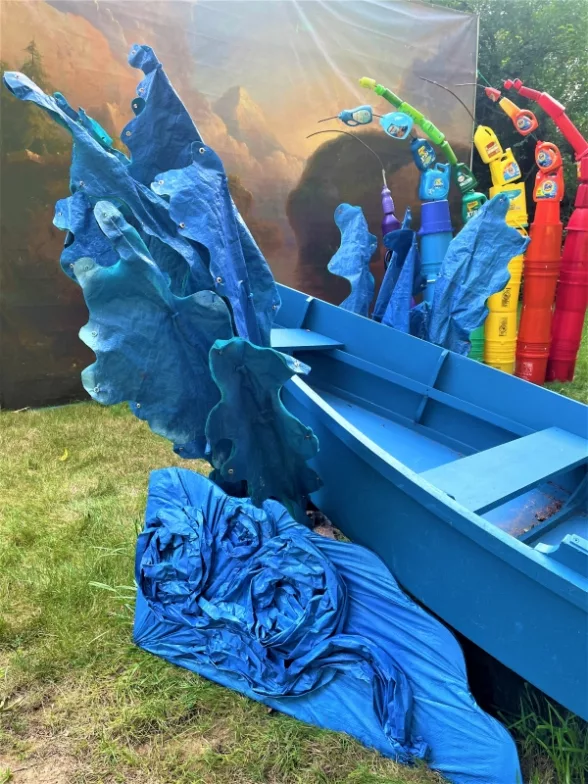
In “America’s Landscape,” the precarious plastic towering “Rainbow” leans into the painting, disappearing into the morning mist among the hills, and adding a sardonic commentary on the ubiquity of plastic in nature. Stage right is an homage to Winslow Homer’s dramatic seascapes. Peoples, who relies as much as possible on upcycled materials, was given permission to use a damaged rowboat she found on the Glen Foerd property. She painted it blue and tipped it prow up, pitched in a storm of roiling waves made from salvaged blue tarps. Foliage from upcycled forest green tarps wraps around the guy wires that support the painting.
Stage left a scattering of red butterflies, who started life as plastic water bottles, flutter on thin rods, adding a visual anchor and subtle activation to the scene.
Peoples is participating in the ArtsFest event at Glen Foerd scheduled for September 24th. She will add performative elements to her three installations. For “America’s Landscape,” she will install a viewfinder that directs a viewer’s experience of the scene.
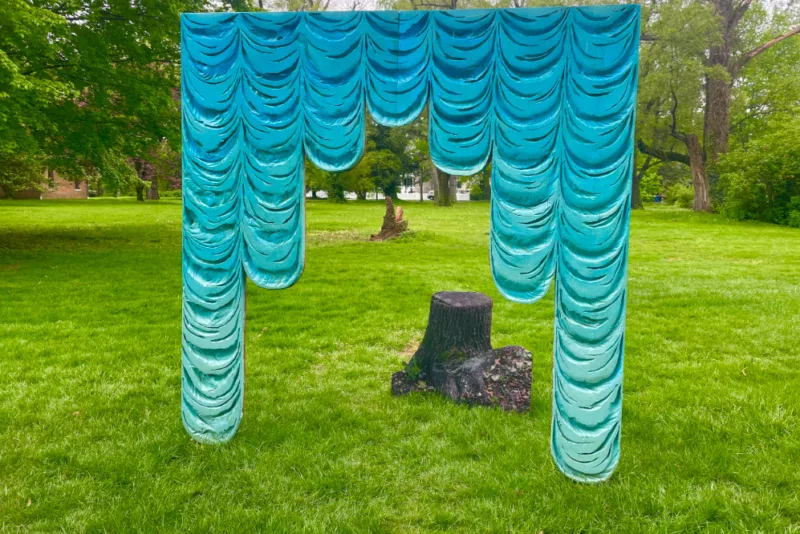
Walking back towards the mansion you’ll find a second installation called “Theatricality of Nature.” This work consists of two artful intrusions that transform the lawn into a stage. An aqua colored curtain with cartoonishly rendered carvings of drapery swags creates an imaginary “fourth wall” plane. The dramatic seven-panel cascading drapery seems to hover in place magically. It arches so that the center panel is the shortest, drawing our attention to an object in the distance. That object is a spiked, splintered tree trunk choked with vines. Beyond the ravaged object is a backdrop of trees. Downstage slightly off center stage left is another tree trunk. This one’s terminus is cleaner. The trunk ends in a level cut. However, there is something baleful about this tree trunk. It is always in shadow, even under the noon sun. It turns out to be a laminated photograph, a prop within the artist’s mise-en-scène. While I was visiting it a bird landed on it and perched for a while, but not long enough for me to capture the performance with my camera.
(I found out after my visit that the framed splintered trunk in the distance was a full, live tree when Peoples first installed the piece. Later it was struck by lightning, creating the uncanny visual echo with the faux stump. Peoples noted about the event that “Imitation and mimicry are at the very heart of this work so I’m pretty excited by this coincidence.“)
The curtain is made from Styrofoam that Peoples carved and painted, then backed with plywood and discretely secured into the ground. In an interview, Peoples mentions that this style of Austrian drapery is also known as a waterfall curtain. The color choice reinforces that conceit. Placing the ersatz curtain in the middle of a mown lawn near a mansion brings up broad questions like, who gets to frame, control, direct our experience of the natural world? When nature becomes performative, who is the audience? Is a weed-free lawn any more natural than a replica of a tree trunk? And how did this sprawling stage that we’re on – the Glen Foerd estate’s 18 acres – come into being, anyway?
The last question is the easiest to answer. Starting in the mid-1800s a succession of two wealthy families owned, erected and remodeled the mansion and other buildings situated at the confluence of the Delaware River and Poquessing Creek. It was bequeathed to the Lutheran Church in the early 1970s, and then through a grassroots effort by neighbors, it came under the ownership of the Glen Foerd Conservation Corporation and the Fairmount Park Commission in 1985. The mansion and grounds are now a historic house museum and public park. Anyone can tour the mansion and view its collections of furnishings and art and stroll the grounds for free during its hours of operation.
Peoples is excited about the ArtsFest activation planned around this work. She wants to remind viewers they have a say in what they are presented with. To that end, she is creating replicas of rotten fruit and vegetables that will be available for viewers to toss on the “stage” on September 24th.
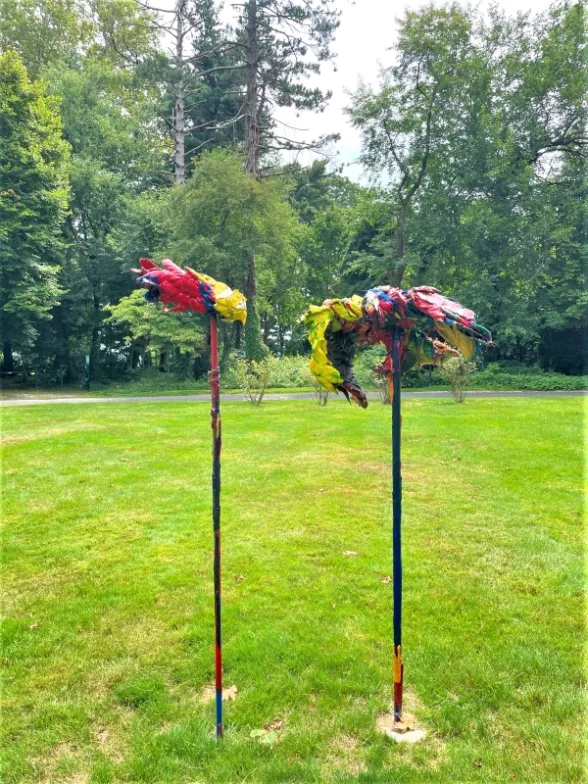
Heading southwest, we encounter the third work Peoples installed during her residency. This is called “Hawkish and Dovish.” Two bird-like figures are set atop slender poles secured into the ground. Embedded in the title is the notion of opposites, yet they are sculpted and finished in the same way, lessening the differences and asking us to question the distinctions between extreme views.
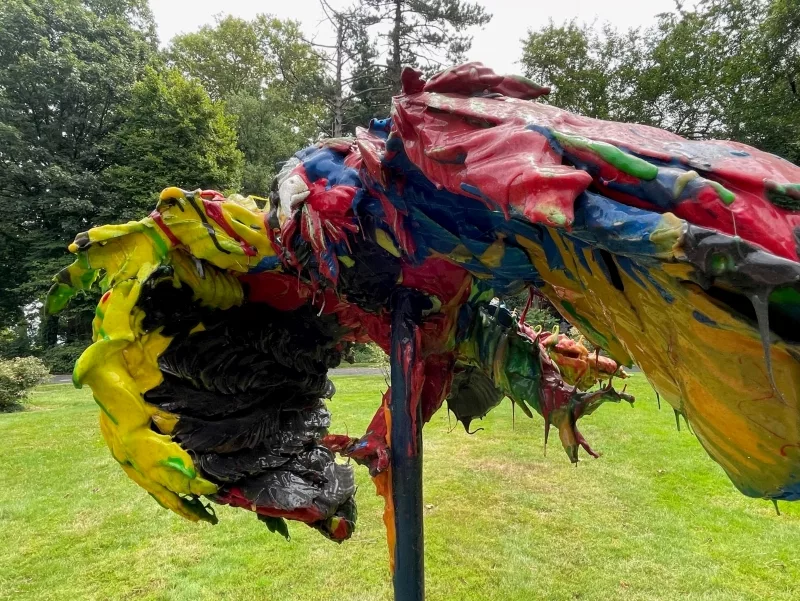
The birds’ bodies are made from wire, newspaper, epoxy clay and the curved Styrofoam salvaged from the curtain in “Theatricality of Nature.” The curved shapes of the reused gougings telegraph feathers and motion in this provocative piece.
Hawks in nature are aggressive birds of prey. In society they have come to symbolize aggressive strategies – the use of military force in resolving conflicts; raising interest rates to curb inflation regardless of its effects on unemployment and borrowing power.
In contrast is the herbivorous dove, a swift and skillful flier, not to be counted out. For millennia doves have symbolized peace. In the political arena they advocate for diplomatic solutions. In finance, a “dovish” approach focuses on promoting economic growth, usually by keeping interest rates low.
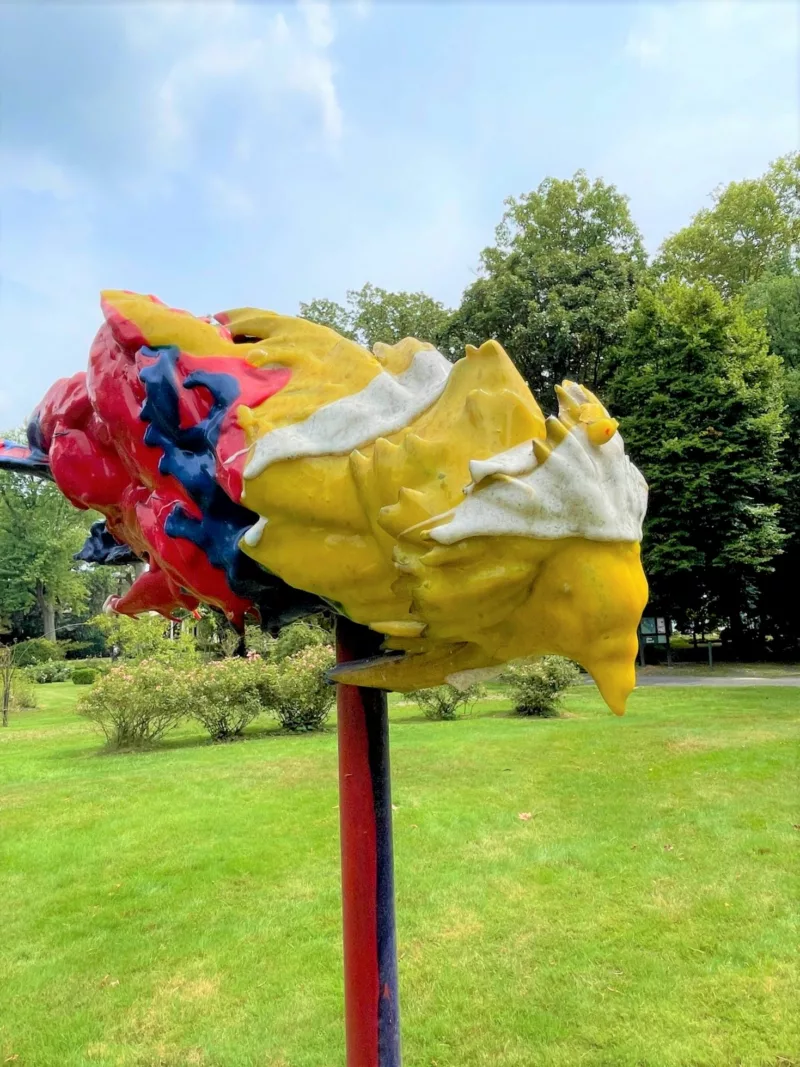
In Peoples’s installation, the two birds are depicted in action. The dove is compact and diving, perhaps in an evasive move; the hawk has its wings unfurled and its talons out. Yet for all their differences, they both inhabit a world where mostly primary colors rule. Peoples has said the color palette relates to the logos of the world’s major oil and gas producers. However, their splashy and drippy coatings of red, yellow, blue and white silicone rubber make them seem as though they’ve flown through a De Stijl storm.
During ArtsFest, Peoples will be calling attention to the influence hawkish and dovish economic strategies have on financial markets. Bears and bulls will not be present, but a yoga practitioner will be. She will sound an 11-inch chakra bowl tuned to the pitch of D, the same pitch of the opening and closing bell used by the New York Stock Exchange.
Peoples’s work strikes a balance between weighty issues and light humor, which seems to be a trend at Glen Foerd. I recently attended Gnome Core, a performance by Glen Foerd’s performer in residence, Alex Tatarsky. Both artists wield comic elements to draw viewers’ attention to contemporary concerns. Peoples also uses bold colors and unexpected materials to draw people into her work. Once there, the question becomes where are you? Her playful use of simulacra blurs the boundaries between participant and observer. I am also heartened by her commitment to using recycled and upcycled materials. There’s a lot of stuff in the world. Peoples shows us how we can reimagine and reframe our references.
Works by Sarah Peoples will be on view at Glen Foerd through the fall.


